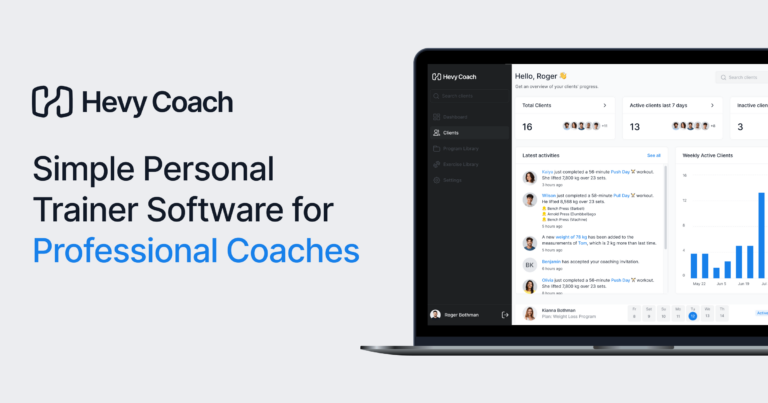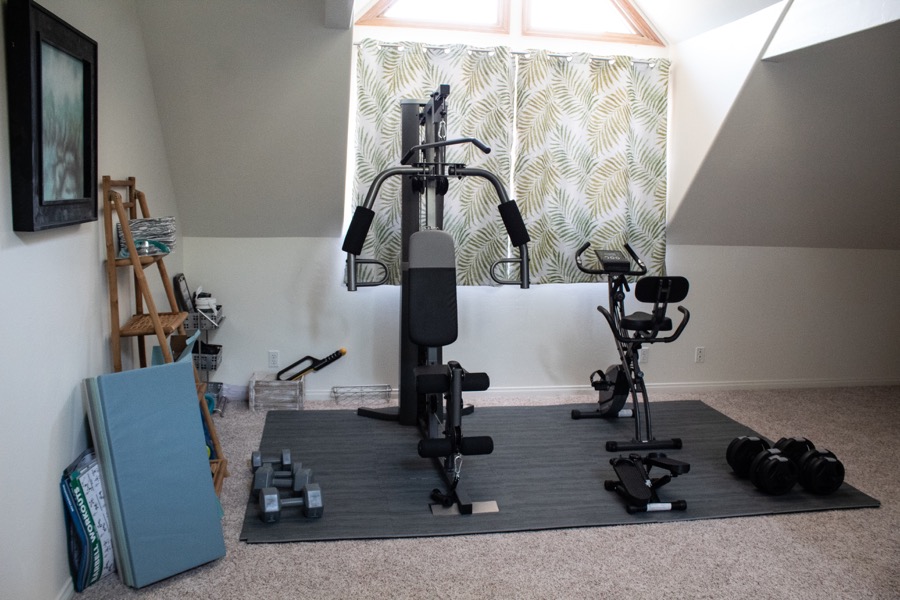Building a personal training business from home can be a lucrative and rewarding way to get your foot in the door and expand your client roster.
The overhead costs are significantly lower than renting a studio, which allows for a low-stress, low-risk start. Plus, many people enjoy working out in a more private environment and might be reluctant to join a gym.
For these and other reasons, you can provide personal training services from home, earn good money, limit expenses, and develop your reputation as a great coach.
Read on to learn what it takes to start a personal trainer business from home, what benefits this approach offers, when to expand your practice and more.
What Is an In-Home Personal Training Business?
An in-home personal training business is one where you offer professional fitness services in the comfort of your home. The alternative is to visit clients at their homes. Such a model provides distinct advantages, such as higher profit margins, a more flexible schedule, and lower start-up costs, making it an attractive option for new and experienced professionals.
First, Understand the Market
Before taking any actionable steps to start a fitness business, you must understand the market and determine if that specific service is in demand where you live. Here are two things you can do:
1. Understand the Supply and Demand
Do people in your area look for personal training services? If so, is there any supply and demand for at-home personal training? One option is to use Google to see what you can find.
First, search for local gyms, studios, and health centers and see if they offer personal training services. If so, do people show interest by asking for prices, booking sessions, or leaving reviews for the services?
Additionally, find as many personal trainers in your area as possible. Visit their social media profiles and websites to see what services they offer. You might even see how much they charge per session if you’re lucky.
You can also use search queries like:
- “at-home personal training + city/town/borough/neighborhood”
- “in-home personal training + city/town/borough/neighborhood”
- “home personal training + city/town/borough/neighborhood”
For example:
“At-home personal training in Manhattan”
The advantage of researching other personal trainers is that you can see how much competition there is. For instance, if you live in a relatively large city but struggle to put together a list of a dozen personal trainers, that could mean two things:
- There aren’t as many personal trainers
- There are plenty of trainers, but they fail to put themselves out there and are difficult to find online
You can capitalize by exploiting the market gap in either case.

Try Hevy Coach
Intuitive personal trainer software, with a world class experience for your clients.
30 day free trial, no credit card required
2. Conduct Online and In-Person Surveys
Another option is to conduct surveys with people in your local area to gauge interest. You can create a simple form with a few questions on Google Forms and share it with people in fitness groups and on social media.
The advantage is that the feedback is anonymous, which allows people to answer all the questions more freely. Plus, the whole thing shouldn’t take longer than a few minutes to fill out.
Potential questions to ask include:
- How often do you currently exercise?
- What type of exercise do you currently do?
- Where do you prefer to exercise?
- Have you worked with a personal trainer in the past?
- Are you interested in personal training services now?
- If so, would you be open to having a personal trainer come to your home, or you going to theirs?
- What factors are important for you when hiring a personal trainer?
- How much would you be willing to pay per session?
How to Start a Personal Training Business from Home: 6 Steps
1. Get a Certification
A personal training certification is not mandatory for running a training business. Still, it can equip you with knowledge and expertise, boost your credibility, and make it easier to sign clients.
While certification doesn’t necessarily mean someone is a skilled and experienced personal trainer, it affects how potential clients look at that person. Going through the course material and passing the exam displays a level of expertise, which is valuable.
Plus, enrolling in many certification programs requires a CPR/AED certification, which can provide peace of mind for your clients.
Being able to recognize a cardiac event and administer CPR can make a huge difference.
Some of the most reputable programs in the US include ACE, ISSA, NASM, ACSM, NSCA, and NCSF. We’ve written about each of these, how much they cost, how long they take to complete, and what the course materials look like here.
2. Calculate Your Initial Costs
While home personal training businesses cost less than renting a studio or starting a small gym, there are still some expenses to consider:
- Liability insurance – as a personal trainer, you need liability insurance to protect your personal assets and business if a client gets hurt during exercise and seeks legal action against you.
Such insurance costs vary depending on location, how many clients you train, etc. On average, general liability insurance costs $200 to $1200 annually. - Renovations – the space you’ve decided to use as your base of operations might need some upgrades. That could include aesthetic improvements (e.g., fixing cracks in walls), installing mirrors, adding ventilation, and adding additional lighting.
- Flooring – proper flooring can protect your floor from heavy weights by absorbing the impact force. Rubber mats are generally ideal, but the cost can add up, especially if your space is large.
- Exercise equipment – the type of equipment you get will largely depend on what training you want to offer. However, even a basic setup can cost well over $1000.
Some good investments include adjustable dumbbells, resistance bands, exercise mats, a squat rack (or folding/half rack if your space is limited), an adjustable bench, and weight plates. - Business structure – setting up your business structure, be it a limited liability company (LLC) or something else, also comes at a price. Potential expenses include filing and legal fees and hiring an accountant.
- Certification – as discussed above, a certification is generally not mandatory but highly beneficial. Consider all the associated costs. For instance, the basic ACE program costs $979.
- Miscellaneous – always add 10 to 20 percent to your estimated costs as a buffer because unexpected expenses tend to creep up, especially when doing something for the first time.

3. Set Up Your Home Gym
Here are a few crucial steps to setting up your private gym at home:
- Measure your available space to determine where your equipment will be. Always leave extra room around each piece of equipment so your clients have enough space to move freely and exercise safely.
For example, when positioning your squat rack, leave enough space on both sides for a full-length barbell to move around without being at risk of hitting something else. - Pick cost-effective and compact equipment. Working with limited space means being more careful of your decisions to maximize training versatility.
For example, purchase one or two pairs of adjustable dumbbells instead of a full dumbbell rack. Also, consider options like a half/folding rack, a 15-kilo barbell, a stationary bike, a resistance band set, and a wall-mounted pull-up bar and dip bar. - Maximize safety. Assemble each piece of equipment carefully and ensure everything is in good condition. Disinfect the equipment regularly and keep your training area free of clutter that can lead to an accident.
If you have plenty of weights, barbells, and other equipment, organize them with items like weight stands and a barbell wall hanger.
Setting up your home gym might seem overwhelming, but remember that you don’t have to purchase everything at once or buy everything brand new. You can get some fantastic deals on second-hand equipment.
4. Market Your Business
The fitness industry is crowded and competitive. Regardless of your credentials and experience, people won’t know you exist unless you market yourself well.
We’ve written extensively on the topic here and here if you’re interested, but let’s list a few quick tips you can use right away:
- Conduct market research. Make sure that what you’re offering is in demand. We discussed that above.
- Identify your niche and expertise. What kind of trainer do you want to be known as––a weight loss expert, hypertrophy specialist, strength coach, or something else?
- Define your ideal client. Who is that person? What challenges are they trying to overcome? What fears and limiting beliefs does the person have?
- Set realistic goals. How many clients do you ideally want to sign every week to turn a profit in the following months? Calculating your startup costs before starting can make it easier to tell if the business model is viable.
- Go on social media. Create profiles on platforms like TikTok, Instagram, and Youtube. Share helpful content and gradually grow your audience, reach, and reputation. Share your services with your following and create polls to gain valuable insight for future services and products.
- Use paid ads. Invest in paid ads on Instagram, Facebook, and other platforms to target people in your area. Craft compelling ads by paying attention to key elements like the headline, call-to-action (CTA), visuals (photos, videos, etc.), and copy (the main text in the ad).
The advantage of ads is that you can use various filters to target people specifically interested in your offer, making it easier to convert leads to customers and get a respectable return on investment (ROI).
We’ve written more on advertising for personal trainers in this guide.

5. Building Relationships with Your Clients
Providing an excellent service is the cornerstone of any successful business. An expensive home gym and the best marketing in the world won’t do you much good if clients don’t reach their fitness goals and don’t like your services.
So, above all else, put your clients first. Go above and beyond for them by creating excellent workout plans, keeping them accountable, helping them stay motivated, and monitoring them closely during each workout.
Communicate with your clients, answer their questions, and track their progress. Doing so will make them feel appreciated and enthusiastic to keep going. More importantly, by tracking their improvements, you show them how much progress they are making, which is incredibly rewarding.
Satisfied clients lead to favorable reviews, compelling testimonials, and word-of-mouth advertising, all of which grow your business organically and for free.
Check out Hevy Coach if you’re looking for a platform that simplifies the process. Create workouts for clients, monitor their performance, track their adherence, respond to their questions, and make adjustments when necessary, all from a single dashboard.
6. Have Clear Rules
Clear rules make communication easier and allow you to run a professional business with fewer hiccups. Here are some to keep in mind:
- Punctuality – your clients must understand the importance of being on time and showing up ready for each workout. A single late client can disrupt your schedule, forcing others to wait.
- Cancellations – clients should notify you in advance if they have to cancel a workout session. That way, you can fill the empty spot with another client or plan out your day better and get personal work done.
- Responsibilities – clearly explain what you expect your clients to bring and do. For example, tell them to bring water, a towel, and comfortable workout clothes.
- Payments – have clear payment rules. When must your clients pay? How much does each session cost? How can a client qualify for a discount? Discuss these and other questions early to avoid confusion or frustration later.
- Boundaries – if you’re going to have clients at your home, clearly set boundaries for what areas they can access. Clients should understand and respect your privacy.
As you gain experience and coach more people in your home, you will inevitably think of other rules, but these should be a good starting point.

Try Hevy Coach
Intuitive personal trainer software, with a world class experience for your clients.
30 day free trial, no credit card required
The Benefits of Starting a Personal Training Business from Home
1. Low Startup Cost
Like an online personal training business, in-home training is a more affordable way to get started and earn your first dollar in the industry.
Still, there are some potential expenses to keep in mind, and it’s always best to add 10 to 20 percent on top of your estimated costs to account for unexpected spending.
2. Typically Higher Profit Margins
Given the lower costs of starting and running an at-home personal trainer business, the profit margins tend to be higher, which means you can make a good living without charging as much or having as many clients.
3. Flexible Schedule
The personal training business model is desirable because it allows for a more flexible work schedule and more free time during the day.
You can set appointments as you see fit and be unavailable at certain times if you want to be with your family, run errands, or work a part-time job.
4. Personalized Environment
The beauty of working from home is that the environment is far more comfortable and familiar, which makes it easier to loosen up and be the best professional possible.
Some trainers struggle to provide excellent service not because they are bad at their job but because they feel anxious.
We must also think about our clients because many of them might not feel comfortable returning to the gym, even though the Covid pandemic is now in the rear-view mirror. Such people might feel more comfortable visiting a personal trainer at their home.
5. No Need to Commute
Another great advantage of working from home is that you don’t have to commute, which saves you a lot of time and money in the long run, especially if you live in a big city.
Of course, that doesn’t apply if you have to go to your client’s homes to offer your services.
6. Opportunity to Transition to Online Training
Personal training opens the door for hybrid (online and in-person) coaching, which can be particularly valuable for clients with less free time.
For example, some clients could visit your home a few times monthly to get a fitness assessment, learn new exercises, get their technique reviewed, and such. However, you deliver most of the coaching online, and clients can work out at home or the gym when they want.
Speaking of a hybrid approach, Hevy Coach is the perfect all-in-one platform because you can use it to deliver workouts, track your client’s progress, and communicate, all from a single dashboard.
Related article: 11 Profitable Fitness Business Ideas for 2024
The Drawbacks of an In-Home Personal Training Business

1. Space Limitations
Depending on the size of your home, you might not have as much room for a gym, which could lead to a somewhat ‘crammed’ training experience for yourself and your clients.
2. Potential Distractions
Any home-based business is subject to potential distractions from family, pets, and chores. Be mindful of these; they can disrupt your sessions and affect client satisfaction.
3. Laws and Regulations
Depending on where you live, there might be restrictions on the type of business you want to conduct. Do your research before filing any paperwork.
Even if no laws keep you from establishing such a business, there could be homeowner association rules that do.
4. Perception
Some of your clients might see a home gym setup as less professional. As a result, they might be reluctant to continue working with you beyond the first session.
As a business owner, your job is to make your home gym look professional. Take good care of your equipment, invest in good lighting, organize the weights and machines intelligently, and invest in quality flooring.
5. Limited Growth Potential
As your business (hopefully) grows, you’ll want to expand by getting more equipment or hiring an extra trainer to help out. That will likely not be possible in a home setting, forcing you to rent a studio if you want to keep expanding.
6. Invasion of Privacy
Having clients come to your home can raise some privacy concerns, so it’s essential to set clear rules and boundaries. Explain what areas of your home are off-limits to clients.
7. Blurred Work/Life Balance
While a home personal training business can offer flexibility, higher profit margins, and more free time, it can blur the line between work/life balance.
For example, if you spend the entire day working with clients, it can be difficult to ‘switch off’ and relax in your home or enjoy a peaceful workout.

Try Hevy Coach
Intuitive personal trainer software, with a world class experience for your clients.
30 day free trial, no credit card required
Final Words
Starting a successful personal training business from home is easier than renting a studio because you have fewer expenses and can enjoy higher profit margins. Plus, the environment is more personal, and you might attract people who want to exercise but are reluctant to join a gym.
That said, renovations, marketing, purchasing the right equipment, and getting a certification (if you don’t have one) can cost a pretty penny. Because of that, we recommend calculating your initial costs and setting realistic client acquisition goals.
Doing these things can help you determine what monthly income you need to turn a profit and how many clients you should sign.
Additionally, look at local laws and regulations to determine if such a business is possible where you live. The last thing you want is to file the LLC papers only to realize that a law or rule stops you from training people at your home.
If all is in order and you can go ahead with this business model, you will enjoy benefits like a more flexible schedule, not spending time or money on commutes, and having a personalized coaching environment.
Check out Hevy Coach if you want to elevate your training practice and serve your clients better. The all-in-one platform allows you to deliver workout plans to clients, track their performance and adherence, answer questions, and make adjustments on the go. The best part? You can do these and other things from a single dashboard. Test Hevy Coach for free with one client.
FAQs
1. How much does starting a personal training business from home cost?
The cost of starting such a business can vary because numerous factors play a role:
- Business-related expenses (establishing a corporation, hiring an accountant, etc.)
- How much renovation your home gym space needs
- What equipment you decide to get (e.g., Rogue Fitness or generic brands)
- How much equipment you get right away (e.g., a complete home gym or just a few pieces of equipment)
- Marketing expenses
2. How can I market my home-based personal training business?
Deliver an excellent service to existing clients to get favorable testimonials and enjoy word-of-mouth advertising. Additionally, look into paid ads on platforms like Instagram and Facebook to target people with fitness and personal training interests in your area.
3. How can I retain clients in my personal training business?
Retaining clients in a personal training business is a combination of providing excellent service, dedicating enough time and answering questions, offering affordable sessions, and building strong relationships based on understanding.




